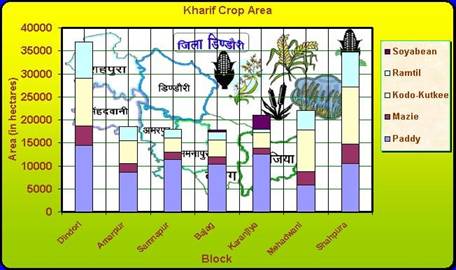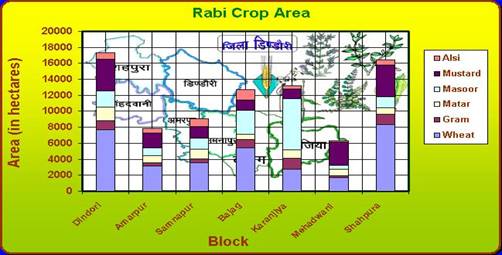A. District Profile
Situated in the central part of India, Madhya Pradesh is a state which has diversified culture and rich natural resources. Having ample natural resources, large geographical area and prospects for development Dindori is still ranked in the backward districts of India due the indicators such as 37% BPL population, low productivity, very backward pockets of habitations, poor health and education facilities in respect of the national and international averages. Inadequate infrastructure is the main reason behind the backwardness of the district.
Formed in 1998 out of Mandla district Dindori district is one of the 48 districts of Madhya pradesh state. Having large geographical area as compared to the other districts (population density 95) the district also has rich natural resources but these resources are still under harnessed. The district is a tribal dominated district having all the seven blocks as tribal blocks notified under TSP by planning commission of India. The district have inadequate field staff in agriculture and health sector and the elected representatives of the PRI’s are also not having good governess capacities due to which the implementation of the service sector and other schemes is very difficult in the district. Poor rural connectivity, no rail network is also the reason behind the exploitation and inaccessibility of extension services in the district. The women literacy rate is also very low as compared to the national and state averages due to which child education is also effected as parents are not aware. The guardians generally do not prefer to send their children for higher education .The district also lags in electrification infrastructure which is a also a pillar for development, there is not even a single 132 KV sub station in district and the electric supply is interrupted due to excessive loads on the low voltage transmission lines and transformers . As evident from the above reasons no big industries can be set up in the district due to poor availability of infrastructures and power supply.
Trend of area/productivity of major crops grown in Kharif & rabi, cropping pattern
B. Scenario of Agriculture & allied department including administrative details
Dindori district is an agro-economy dependant district and agriculture is a major livelihood means for the rural people of the district. The major crops of the district are Rice, Kodo-kutki, Maize, Nizer Ramtil and Arhar. The district has only agriculture as the main occupation of most of the people in the district, which provides partial or full employment to 80% of the population of the district. But the income from it does not meet even their basic needs of life. Most of the farmers are poor. For meeting their basic consumption needs, they have to borrow money from moneylenders at very high rates of interest.
Un harnessed natural resources and use of traditional methods of agriculture result in low crop yields and hence low income from crops. Therefore migration to cities and towns for livelihood support is common in the district. Normally, 22% of the people from most of the villages migrate seasonally for 6 months or so every year and in some cases, they are out of their villages for almost whole of the year.
The districts agriculture production is very low in compare to the land available for agriculture .The main reason behind this is the lack in irrigation facilities and primitive agriculture practices by the agriculture labors and farmers. The major constraints in enhancement of agriculture production and livelihood development through agriculture and horticulture is the lack of awareness and poverty due to which the farmers which are marginal and small (as per land holdings) in majority doesn’t use fertilizers only very few of them use fertilizers in their crops as well as extension of irrigation facilities is inadequate.
As discussed earlier the land quality does not allow growing paddy in few of the part of the district. As far as cereal crops are concerned most of the farmers grow cereal crops for self-consumption only, because productivity is not enough to fulfill the need of people. Farmers sell cereal produce in market very rarely. Mainly Niger and Mustard are grown as cash crop. Maize - Mustard crop rotation is practiced in backyard and FYM is used in this rotation and field crops are grown without using fertilizer. Crop rotation Kodo/Kutki - Niger- Kodo/Kutki - fallow is practiced in bharra land. Paddy-wheat crop rotation is in practice in all the blocks except Karanjia Block where Paddy - lentil crop rotation is used. Maize-Mustard cropping pattern commonly used in good quality soil.
The table below shows the production under major crops in the district in various seasons:
Crops are grown in two seasons only i.e. Kharfi and Rabi. Negligible area falls under Jayad season because irrigation facility is poor. Crop area is described below
Kharif Crop Area

above chart depicted that Kodo-Kutki, Maize, Ramtil and paddy are produced in all the blocks. Most of the area (around 4000 ha.) under Soybean falls in Karanjia Block and very little area of Soybean is covered in Bajag Block. Dindori Block ranks first in Paddy and Niger area while Shahpura Block covers highest area of Kodo-Kutki amongst all the Blocks. Area under Maize is more or less same in all the Blocks. Cropping pattern shows that soil quality and water retention capacity of soil is better in Dindori and Karanjia Block. More than 70% area of total crop area of Shahpura and Mehadwani Blocks comes under Niger and Kodo-Kutki which is an indicator of stony (bharra) soil. Farmers sow Maize first then Paddy in Kharif season because Maize and Paddy are staple foods and farmers want to get these crops harvested earlier.
| S. No. |
Major crops & enterprises |
Thrust Areas |
Potential |
Major problem identified |
| 1 |
Paddy |
Integrated Nutrient Management |
Use of balance dose of Fertilizers |
Imbalance use of fertilizers |
| Integrated Weed Management |
Management of Weeds by using IWM |
Infestation of weeds |
| Varietal Evaluation |
Introduction of high yielding varieties |
Low yield due to use of Local Seed Material |
| Improved implement |
Use of Improved Farm Implements |
Broad casting method of sowing |
| Integrated Pest & Disease management. |
Management of Insect Pest and Diseases by using IPM and IDM |
Incidence of stem borer & diseases |
| 2 |
Arhar |
Integrated Nutrient management |
Use of balance dose of Fertilizers |
Imbalance use of fertilizers |
| Varietal Evaluation |
Introduction of high yielding varieties |
Low yield due to use of Local Seed Material |
| Integrated Pest & Disease management. |
Management of Insect Pest and Diseases by using IPM and IDM |
Infestation of pod borer & wilt disease |
| 3 |
Niger |
Varietal Evaluation |
Introduction of high yielding varieties |
Low yield due to use of Local Seed Material |
| Integrated Weed management |
Management of Weeds by using IWM |
Infestation of weed (Cuscuta) |
| Improved implement |
Use of Improved Farm Implements |
Broad casting method of sowing |
| 4 |
Wheat |
Integrated Nutrient management |
Use of balance dose of Fertilizers |
Imbalance use of fertilizers |
| Varietal Evaluation |
Introduction of high yielding varieties |
Low yield due to use of Local Seed Material |
| Integrated Pest & Disease management. |
Management of Insect Pest and Diseases by using IPM and IDM |
Infestation of Termite |
| 5 |
Gram |
Varietal Evaluation |
Introduction of high yielding varieties |
Low yield due to use of Local Seed Material |
| Integrated Nutrient Management |
Use of balance dose of Fertilizers |
Imbalance use of fertilizers |
| Integrated Pest & Disease management. |
Management of Insect Pest and Diseases by using IPM and IDM |
Infestation of pod borer & wilt disease |
| 6 |
Horticultural crops
(a)Fruit Crops (Guava, Mango, Ber, Aonla,Custard Apple, JackFruit, Drumstick) |
Less acreage of fruit crops |
Need to increase area under fruit crops. |
Less acreage of improved variety |
| Varietal Evaluation |
Increases area of Improved variety |
Low yield of fruit plants |
| Integrated Nutrient Management |
Use of balance dose of Fertilizers |
No use of manures and fertilizers |
| (b) Vegetable Crops (Okra,Tomato, Brinjal, Chilli, Cabbage, Cauliflower, Bottle gourd Cowpea, Raddish, Spinach etc.) |
Varietal Evaluation |
Introduction of improved variety |
Use of Local seed materials |
| Less acreage of vegetable crops |
Need to increase area under vegetable crops |
Low acreage of vegetable area |
| Integrated Nutrient Management |
Use of balance dose of Fertilizers |
Low yield due to imbalance nutrient management |
| Nursery Management |
Nursery Management |
Poor nursery management |
| Integrated Pest & Disease management |
Management of Insect Pest and Diseases by using of IPM and IDM |
Infestation of insect-pest and diseases |
| (c) Spices Methi, Coriander, Chilli, Onion, Garlic, Turmeric, Ginger |
Varietal Evaluation |
Use of Improved varieties |
Low yield due to use of local seed materials |
| Integrated Nutrient Management |
Use of balance dose of Fertilizers |
Use of Imabalance dose of Fertilizer |
| Need to increase area |
Need to increase area |
Less acreage under crop |
(d) Flowers
Marigold and Gallardia |
Varietal Evaluation |
Introduction of improved variety |
Unavailability of improved variety |
| 7 |
Livestock |
Nutritive feeding. |
Balance Feeding |
Low milk yield in cow & buffalo |
| Integrated Disease management. |
Management of various diseases in animals |
Infestation of various diseases in
Animals. |
| 8 |
Soil Heath |
Soil & water conservation. |
|
Undulated topography of land, which leads to soil erosion. |
| 9 |
Small* millet |
Integrated Nutrient management |
Use of balance dose of Fertilizers |
Imbalance use of fertilizers |
| Improved implement |
Use of Improved Farm Implements |
Broad casting method of sowing |
| Varietal Evaluation |
Increases area of Improved variety |
Low yield due to use of Local Seed Material |






